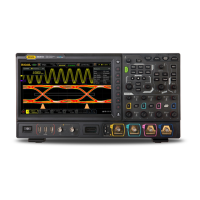Chapter 5 To Trigger the Oscilloscope RIGOL
MSO8000 User Guide 5-41
CAN Trigger (Option)
MSO8000 can trigger on the start of a frame, end of a frame, frame of the specified
type (e.g. Remote, Overload, Data, etc.), or error frame of the specified type (e.g.
Answer Error, Check Error, Format Error, etc.) of the CAN signal.
The data frame format of the CAN bus is as shown in the figure below.
Figure 5-17 Data Frame Format of the CAN Bus
Trigger Type:
Press Type, and then rotate the multifunction knob to select "CAN". Press down
the knob to select the trigger type. Then, the current trigger setting information is
displayed at the upper-right corner of the screen, as shown in the figure below. You
can also press Type continuously to select the trigger type or enable the touch
screen to tap the desired trigger type and select it.
Source Selection:
Press Source to open the signal source list and select CH1-CH4 or D0-D15. For
details, refer to descriptions in "Trigger Source". The current trigger source is
displayed at the upper-right corner of the screen.
Note: Only when we select the channel (that has been input with signals) as the
trigger source, can we obtain a stable trigger.
Trigger Condition:
Press When to select the desired trigger condition.
⚫ SOF: triggers at the start of a frame.
⚫ EOF: triggers at the end of a frame.
⚫ Remote ID: triggers on the remote frame with the specified ID. Set the following
parameters:
➢ Press Extended ID to enable or disable the extended ID.
➢ Press Bit X to set the data bit that needs to be operated on. For setting
methods, refer to descriptions in "I2C Trigger (Option)".
⚫ Overload: triggers on the CAN overload frames.

